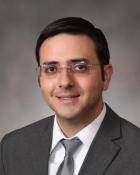Ventricular fibrillation can be a life-threatening emergency that requires immediate medical attention. If you need emergency care, call 911 right away. If you have any of the following symptoms, seek immediate care:
- You feel dizzy or lightheaded.
- You have fainted or feel as if you might faint.
- You experience shortness of breath.
Ventricular fibrillation is a type of abnormal heart rhythm or arrhythmia that occurs in the ventricles, the lower chambers of the heart. Typically, the heart’s electrical impulses cause the heart muscles to contract, which creates a heartbeat. When ventricular fibrillation is present, the heart’s electrical activity is out of rhythm and causes the ventricle muscle fibers to twitch rather than contract. As a result, the heart is unable to pump blood to the brain and the rest of the body, resulting in sudden cardiac arrest.
The team of cardiology experts at UK Gill Heart & Vascular Institute provides some of Kentucky’s leading care for ventricular fibrillation.
Signs of ventricular fibrillation are severe. A person experiencing ventricular fibrillation will likely lose consciousness as the heart fails to pump enough blood to the brain and muscles. Before collapse, a person experiencing ventricular fibrillation may have:
- Chest pain
- Dizziness
- Nausea
- Rapid or irregular heartbeats
- Shortness of breath
Sometimes ventricular fibrillation can’t be prevented. It can be caused by heart muscle damage that develops during or after a heart attack or as the result of another form of heart disease. Ventricular fibrillation can also develop due to genetic conditions, electrolyte abnormalities or the use of some types of medication.
If you have been diagnosed with a condition that may cause ventricular fibrillation, you may need an implantable cardiac defibrillator. This device can shock your heart into rhythm to prevent cardiac arrest. Medicines can also reduce the risk of ventricular fibrillation in patients who have medical conditions that can interfere with the heart’s rhythm.
These conditions or factors can increase the risk for ventricular fibrillation:
- Certain medicines
- Congenital heart disease
- Electrocution
- Heart muscle damage caused by a heart attack or a sudden blow above the heart
- Heart muscle disease, such as cardiomyopathy
- Heart surgery
- Potassium levels that are very high or very low
- Low magnesium levels
- Reduced blood flow to the heart
Once the immediate danger of ventricular fibrillation has passed and your emergency care team has restored normal heart rhythm, you'll be asked to schedule a follow up visit with our Adult Heart Rhythm Program to help determine the underlying cause of your issue and how to prevent future episodes.
Your first visit to UK Gill Heart & Vascular Institute’s Adult Heart Rhythm Program is a time of education and introductions. You meet members of your care team and learn about detecting, treating and living with arrhythmias.
Diagnosing arrhythmias is a unique process that requires detective work. One of the most important steps toward diagnosis is listening to your story. Your team will ask a lot of questions about your symptoms and medical history. The goal is to gather all possible information that can help pinpoint the source of your heart issue. Information from this first meeting helps your team determine the next step in diagnosis.
Based on information from this meeting, your healthcare provider may give you a monitor to wear. This monitor tracks your heart rhythm and allows your team to determine the type of arrhythmia you have. Additionally, your team may prescribe one or more diagnostic tests. If appropriate, these tests take place on a different day, and your team helps schedule them at your convenience.
When coming to your first arrhythmia appointment, plan to do the following:
- Arrive early. You may need to fill out paperwork when you arrive. Getting to your appointment early ensures you have time to complete paperwork without feeling rushed.
- Bring a current list of medicines or supplements you take. You should also list any surgeries you’ve undergone, symptoms you’ve experienced and other past health issues.
- Dress comfortably. Working toward a diagnosis takes time. Comfortable clothes help you remain relaxed and attentive throughout your visit.
- Eat and drink normally. You won’t undergo imaging or other testing at your first visit. Therefore, there are no dietary restrictions.
- Have your insurance information on hand. UK HealthCare accepts most insurers, and financial assistance is available.
- Request a loved one to join you. Bring a family member or friend with you to take notes and ask questions you may not think of asking.
Where we are located
The UK Gill Heart & Vascular Institute is located at 800 Rose St. in Pavilion G, on the first floor of UK Albert B. Chandler Hospital. We will mail you a map and directions when your appointment is scheduled.
Patient drop-off
Patients can be dropped off in front of the main entrance to Albert B. Chandler Hospital at 1000 S. Limestone. If you are dropped off at the main entrance, you’ll enter the revolving doors on the ground floor of the hospital. Take the main stairs just to the left (or elevator across the atrium) to the first floor of Pavilion A.
After climbing the stairs or taking the elevator, turn left. You’ll pass the Kentucky Wall and Kentucky Children’s Hospital on your right. Continue to the end of the hall until it comes to a T shape. Turn left and the Gill clinic entrance is across from an open area housing the organ donor wall.
Parking
It is easiest to park in the UK HealthCare Parking Garage, across from the hospital at 110 Transcript Ave.
There are two paths from this garage to the Gill clinic:
- You may take the free shuttle from Level A of the parking garage. You’ll exit the shuttle at the Pavilion A/ Pavilion G stop in front of the main entrance to the hospital. After climbing the stairs or taking the elevator, turn left. You’ll pass the Kentucky Wall and Kentucky Children’s Hospital on your right. Continue to the end of the hall until it comes to a T shape. Turn left and the Gill clinic entrance is across from an open area housing the organ donor wall.
- From Level C of the parking garage you may walk or take a golf cart across the pedway to the first floor of Pavilion A. Turn left past the help desk and walk away from the dining hall. You’ll pass the Kentucky Wall and Kentucky Children’s Hospital on your right. Continue to the end of the hall until it comes to a T shape. Turn left and the Gill clinic entrance is across from an open area housing the organ donor wall.
If you need help finding your way, information desks are located inside the main entrances to Pavilion A, both on the ground floor and at the end of the pedway on the first floor. You may also call the information desk at 859-323-5816.
Our Adult Heart Rhythm Program experts help residents of Central Kentucky and beyond regain proper heart rhythm every day. To improve the future of arrhythmia treatment and management, they also participate in clinical trials.
At any given time, UK Gill Heart & Vascular Institute staff engages in trials for new medicines or devices. This gives you access to arrhythmia treatment not available at many other facilities.
If you’re a candidate for an ongoing trial, your care team will discuss the possibility with you.









